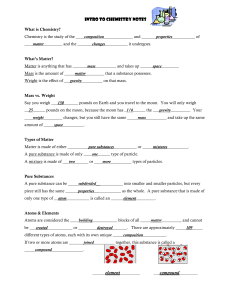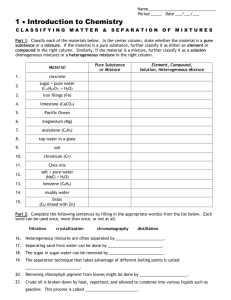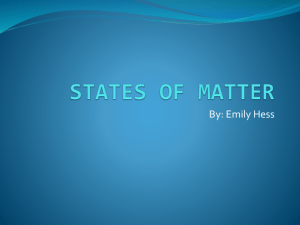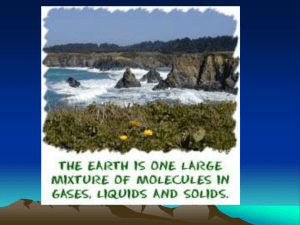Matter - Cloudfront.net
advertisement
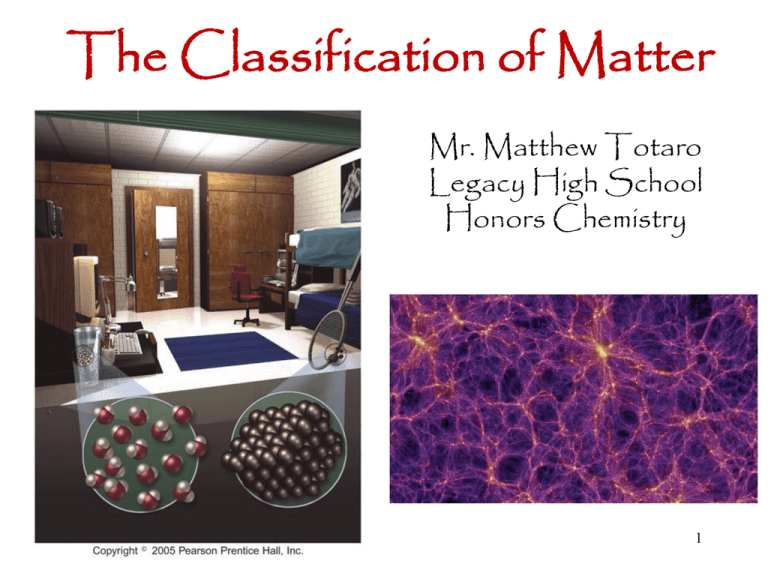
The Classification of Matter Mr. Matthew Totaro Legacy High School Honors Chemistry 1 In Your Room • Everything you can see, touch, smell or taste in your room is made of matter. • Chemists study the differences in matter and how that relates to the structure of matter. 2 What Is Matter? • Matter is defined as anything that has mass and occupies space. • Even though it appears to be smooth and continuous, matter is actually composed of a lot of tiny little pieces we call atoms and molecules. 3 Atoms and Molecules • Atoms are the tiny particles that make up all matter. • In most substances, the atoms are joined together in units called molecules. The atoms are joined in specific geometric arrangements. 4 The Classification of Matter 5 Classifying Matter by Composition • Matter that is composed of only one kind of substance is called a pure substance. • Matter that is composed of different kinds of substances is called a mixture. Pure Sugar Cubes 6 Copper — a Pure Substance 7 Brass — an example of a Mixture Brass is a mixture of Copper and Zinc 8 Practice—Classify the Following as Pure Substances or Mixtures • 24 carat Gold • Granite—a rock with several visible minerals in it. • Water • Iron 9 Practice—Classify the Following as Pure Substances or Mixtures, Continued • 24 Carat Gold necklace = pure substance. • Granite—a rock with several visible minerals in it = mixture. • Water = pure substance. • Iron nail = pure substance. 10 Classification of Pure Substances • Substances composed of a single type of atom are called elements. Basic building blocks of matter. Composed of single type of atom. This type of pure substance is found on the periodic table. Ex: Copper – found on the periodic table with single atoms. • Substances that are made of more than one type of atom are called compounds. Chemical combinations of elements. Compounds = two or more different kinds of atoms. Ex: Table Salt = NaCl, Sodium atoms combined with Chlorine atoms 11 Copper – an example of an Element 12 Table Salt (NaCl) – an example of a compound 13 Classification of Pure Substances Elements 1. Made of one type of atom. (Some elements are found as multiatom molecules in nature.) 2. Combine together to make compounds. Compounds 1. Made of one type of molecule, or array of ions. 2. Molecules contain 2 or more different kinds of atoms. 14 Practice—Classify the Following as Elements or Compounds • Chlorine, Cl2 • Table sugar, C12H22O12 • Oxygen, O2 • Water, H2O 15 Practice—Classify the Following as Elements or Compounds, Continued • Chlorine, Cl2 = element. • Table sugar, C12H22O12 = compound. • Oxygen, O2 = element. • Water, H2O = compound. 16 Classification of Mixtures • Mixtures are generally classified based on their uniformity. • Mixtures that are uniform throughout are called homogeneous. Also known as solutions. Mixing is on the molecular level. • Mixtures that have regions with different characteristics are called heterogeneous. 17 Kool-Aid in Water – a Homogeneous Mixture 18 Chocolate Chip Cookie– a Heterogeneous Mixture 19 Classification of Mixtures, Continued Heterogeneous 1. Made of multiple substances, whose presence can be seen. 2. Portions of a sample have different composition and properties. Homogeneous 1. Made of multiple substances, but appears to be one substance. 2. All portions of a sample have the same composition and properties. 20 Practice—Classify the Following as Homogeneous or Heterogeneous • A mixture of Kool-Aid and water. • A mixture of table sugar and black pepper. • A mixture of sugar dissolved in water. • Oil and vinegar salad dressing. 21 Practice—Classify the Following as Homogeneous or Heterogeneous, Continued • A mixture of Kool-Aid and water = homogeneous • A mixture of table sugar and black pepper = heterogeneous • A mixture of sugar dissolved in water = homogeneous • Oil and vinegar salad dressing = heterogeneous 22 Classifying Matter 23


